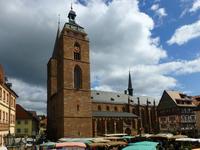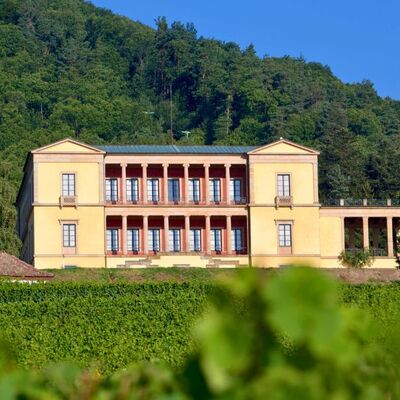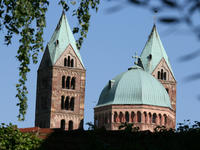Castles and castle ruins
The numerous castles and fortifications in the Palatinate are among the most ancient and impressive attractions of the Palatinate cultural landscape.
The Stiftskirche in Neustadt an der Weinstrasse
The Collegiate Church, with its two unequal towers, is the largest Gothic church and artistically the most valuable of the Palatinate. It dates back to 1356 at the behest of the Elector Ruprecht Wittelsbach.
Hambach Castle
Overlooking the Rhine Valley, the German Wine Street Wine and set against a background of the Palatinate Forest is the impregnable Hambach Castle with its rich past and which has written a page in German history. The manifestation of the patriots of 1832, when, for the first time, the flag of black, red and gold was hoisted black, made these ruins famous. In the year 1919, and again in 1949, the castle was chosen as the national emblem of Germany. Inside is a new concept of interactive museum where guests are invited to be protagonists of this story and its revolutionary slogans: 1° European Revolution, 2° Birthday Banne,r 3° Freedom of the press, 4° Revolution, parliament and constitution, 5° Human Rights and Peace
Flyer “Hambach Castle“
Villa Ludwigshöhe
King Ludwig I (1786-1868) was so fond of Italy that had an Italian-styled villa erected as a summer residence in the Palatinate. Located at the highest point of the village of Edenkoben, on the German Wine Street, where the vineyards bordering the dense forest of the Palatinate look over the beautiful landscape of the Valley of the Rhine.
Since 1975, the Villa Ludwigshöhe has been in possession of the state of Rhineland-Palatinate, and the first floor houses a permanent exhibition of over 100 works of the painter and graphic artist, Max Slevogt (1868-1932). This artist is considered to be one of the most important representatives of German Impressionism.
Around the German Wine Route of the Palatinate
Speyer – Cathedral
This Romanesque cathedral owes its birth to the first Salian emperor , Conrad II , who, shortly after being elected King of Germany in 1024, erected this, the largest church of its time, as an offering to God. UNESCO World Heritage Site.
Mainz Cathedral - the Gutenberg Museum
The six towers of the cathedral date back to the XI- XIII century. The impressive cathedral standing in the centre of the city was also the centre of political power. The archbishop of the city was also " Kurfürst ", (Elector) , one of seven powerful noblemen who crowned the emperor of Germany . Along with the cathedrals of Worms and Speyer, Mainz Cathedral is one of the finest examples Romanesque church architecture .
The Gutenberg Museum (a museum illustrating the history of printing)
Heidelberg - Heidelberg Castle
Heidelberg Castle, one of Germany's most famous castles, is the city’s landmark and was originally a magnificent palace for the nobility of the Palatinate. After its destruction in 1689 and again in 1693 it was only partially restored.
Strasbourg
Strasbourg Cathedral is one of the most famous churches in France. With a height of 142 metres it is a Roman Catholic cathedral dedicated to Our Lady, also called Notre-Dame or Liebfrauenmünster, respectively, in French and German. La Petit France Strasbourg is a picturesque area with its waterways that once housed fishermen, millers and tanners.







